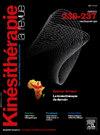患者治疗教育的发展:物理治疗师的机会是什么?
Q4 Medicine
引用次数: 0
摘要
慢性病是卫生系统面临的主要挑战。为了解决这些问题,患者的治疗教育是护理过程的一部分,并有助于更全面的健康促进政策。这种整体的、协作的方法旨在提高患者及其家人的生活质量。它基于四个基本步骤,并提供各种格式,以适应每个人的需要和护理环境。这种传统上以医院为基础的做法正在城市中逐渐普及,可以通过使用数字工具来促进获取。这些不同的锻炼方式在组织、协作和患者随访方面都有各自的优势和限制。教育方法是优化患者护理的杠杆,也是恢复患者实践意义的一种手段。它还提出了挑战,使个人、关系和组织层面的发展成为可能。今天,由于它的扩展和越来越多地融入他们的初始培训,患者的治疗教育完全开放给物理治疗师。这些专业人员有机会并有兴趣在改变卫生实践方面发挥关键作用。慢性疾病是我们医疗保健系统面临的主要挑战。因此,治疗性患者教育是患者护理的一个组成部分,有助于制定更全面的健康促进政策。这种整体的、协作的方法旨在提高患者及其家人的生活质量。它以四个基本阶段为基础,提供了适合个人需要和护理背景的各种格式。从历史上看,它是一种以医院为基础的做法,正在逐步扩展到门诊环境,可以通过使用数字工具促进对它的访问。这些不同的工作方式在组织、协作和患者随访方面都有自己的优势和限制。教育方法是优化患者支持的工具,也是一种赋予患者实践意义的手段。它还提出了使个人、关系和组织发展成为可能的挑战。今天,由于其扩展和日益整合到初始培训课程,治疗患者教育对物理治疗师完全开放。这些专业人员有机会在医疗保健实践的发展中发挥关键作用,必须加以加强。本文章由计算机程序翻译,如有差异,请以英文原文为准。
L’essor de l’éducation thérapeutique du patient : quelles opportunités pour les kinésithérapeutes ?
Les maladies chroniques représentent un enjeu majeur pour le système de santé. Pour y faire face, l’éducation thérapeutique du patient s’inscrit dans le parcours de soins et contribue à une politique plus globale de promotion de la santé. Cette approche holistique et collaborative vise à améliorer la qualité de vie du patient et de ses proches. Elle repose sur quatre étapes fondamentales et propose des formats variés adaptés aux besoins de chacun et aux contextes de prise en soin. Cette pratique, historiquement hospitalière, se répand progressivement en ville et son accès peut être facilité par le recours aux outils numériques. Ces différentes modalités d’exercice présentent chacune leurs avantages et contraintes en matière d’organisation, de collaboration et de suivi du patient. La démarche éducative est un levier pour optimiser l’accompagnement du patient et un moyen de redonner du sens à sa pratique. Elle soulève également des défis qui permettent d’évoluer sur les plans personnel, relationnel et organisationnel. Aujourd’hui, grâce à son expansion et à son intégration croissante dans leurs formations initiales, l’éducation thérapeutique du patient s’ouvre pleinement aux kinésithérapeutes. Ces professionnels ont l’opportunité de jouer un rôle clé dans l’évolution des pratiques de santé et ont tout intérêt à s’en saisir.
Chronic diseases represent a major challenge for our healthcare system. In response, therapeutic patient education is an integral part of patient care, contributing to a more global policy of health promotion. This holistic, collaborative approach aims to improve the quality of life of the patient and his family. It is based on four fundamental stages and offers a variety of formats tailored to individual needs and care contexts. Historically a hospital-based practice, it is gradually spreading to outpatient settings and its access can be facilitated by the use of digital tools. These different ways of working each have their own advantages and constraints in terms of organization, collaboration and patient follow-up. The education approach is a lever for optimizing patient support and a means of giving meaning back to one's practice. It also raises challenges that enable personal, relational and organizational development. Today, thanks to its expansion and increasing integration into initial training courses, therapeutic patient education is fully open to physiotherapists. These professionals have the opportunity to play a key role in the evolution of healthcare practices and must seize it.
求助全文
通过发布文献求助,成功后即可免费获取论文全文。
去求助
来源期刊

Kinesitherapie
Medicine-Rehabilitation
CiteScore
0.40
自引率
0.00%
发文量
135
期刊介绍:
Kinésithérapie, la revue adresse aux praticiens et aux étudiants qui veulent lire des informations accessibles et utiles. Ce est la première revue francophone paramédicale à être indexée dans une base de données internationale - Cumulative Index to Nursing and Allied Health Literature : CINAHL.
 求助内容:
求助内容: 应助结果提醒方式:
应助结果提醒方式:


